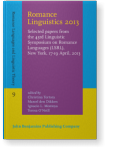Old French possessives and ellipsis
Sáez (2011), to account for Spanish definite articles in ellipsis contexts, such as mi libro y el [e] de Juan ‘my book and that of John’, proposes the Stress Condition on Remnants (SCR), which disallows unstressed syntactic elements to be anaphoric, while allowing definite articles to license empty categories. The focus of our paper is Old French (OF) possessive constructions and their elliptical expressions, such as le mien livre ‘my book’ and le [e] de Jean ‘that of Jean’. OF had a more extensive inventory of possessive constructions than Modern French (MF): lexical genitives, prenominal possessives, and lexical and possessive ellipsis constructions. Adopting Arteaga & Herschensohn’s (2010, 2013) proposal for lexical genitives, Sáez’s (2011) SCR, and Lobeck’s (1995) conditions on ellipsis, we argue that two major diachronic changes led to a difference in licensing of possessives from OF to MF: one, the erosion of morphological marking that led to a loss of the OF two case system, reducing feature strength to license ellipsis (Lobeck 1995), and two, the fact that definite articles became clitics and Phase Heads and thus became subject to the SCR as the prenominal nP domain (Carstens 2003) became a clitic zone prohibiting prenominal stressed possessives.
